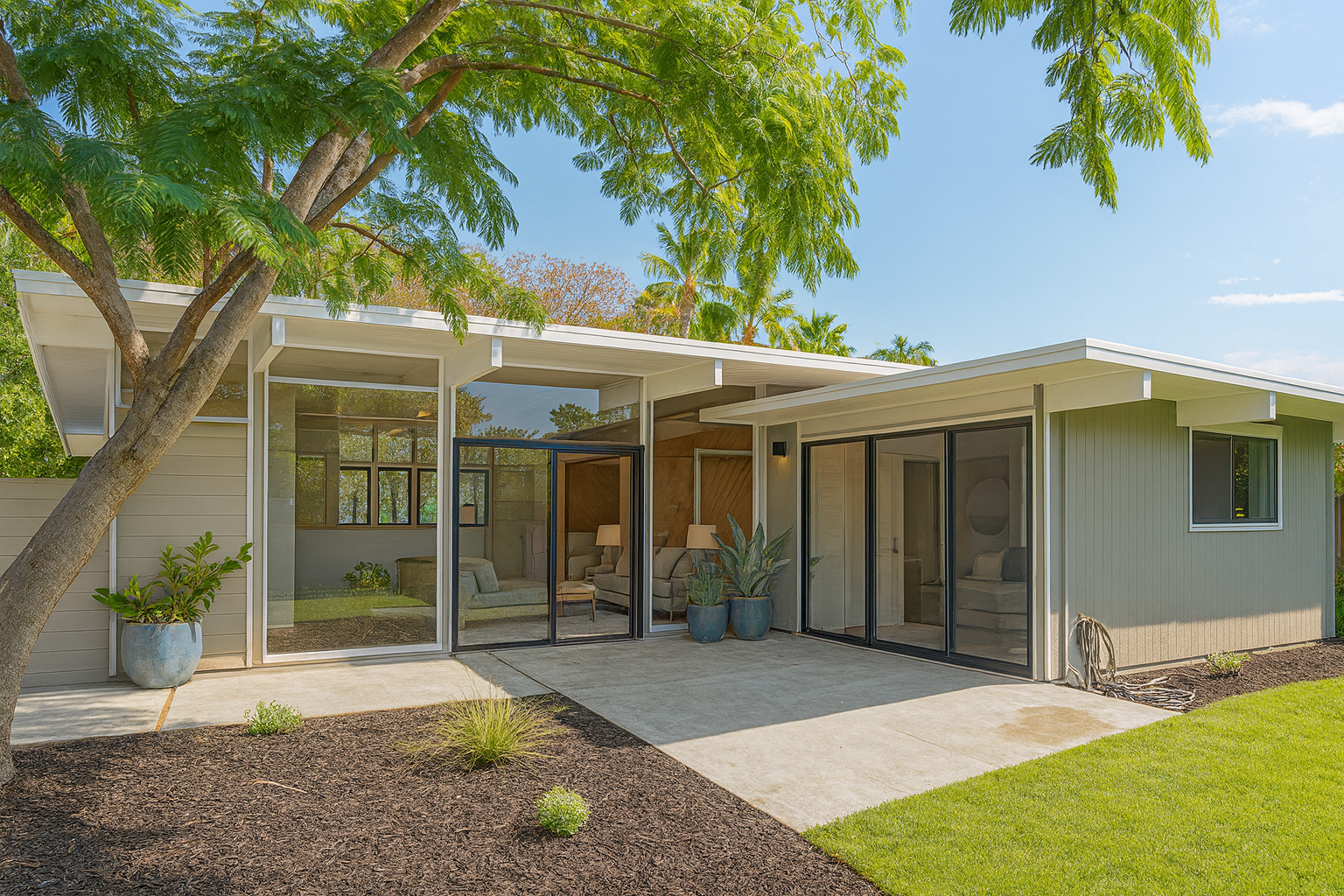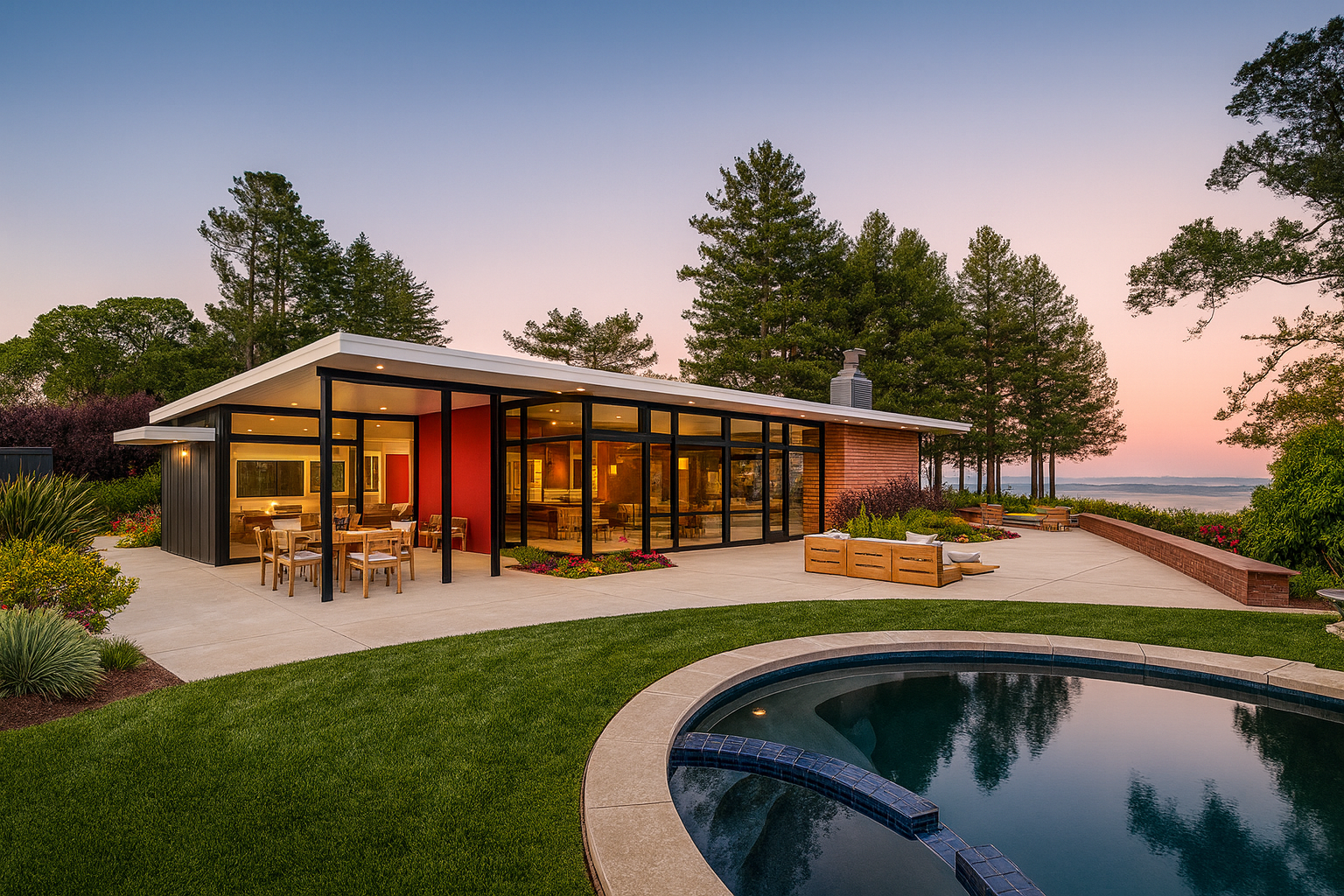The Marin Mid-Mods: Light, Landscape, and the Legacy of Modernism
Terra Linda — The Twin Hearts of San Rafael
San Rafael’s Terra Linda North and South together form the densest concentration of Eichler homes in Marin County. Developed between 1955 and 1965, these neighborhoods capture the full evolution of Eichler design—from flat-roofed atrium models to angular A-frames and even split-level interpretations suited to Marin’s undulating terrain.
Terra Linda North, closer to Las Gallinas Avenue, was the earlier development: crisp, low, and deeply symmetrical. Homes here exhibit radiant-heated slabs, tongue-and-groove ceilings, and signature walls of glass that open to private courtyards. Many remain remarkably intact—period fixtures, globe lights, original paneling—a rarity in California’s remodel-hungry market.
Terra Linda South, set against the backdrop of the rolling Terra Linda Ridge, represents Eichler’s architectural maturity. The roofs pitch higher; clerestory windows multiply; the sense of spatial generosity expands. The Marinwood Plaza and Las Gallinas Creek trails add walkable charm, and the area’s excellent schools—within the Dixie School District—have anchored multi-generational continuity for over half a century.
Terra Linda’s charm lies in its equilibrium: design purity, livability, and a palpable sense of community. Block parties and modern home tours are still part of the culture. For design lovers, this neighborhood remains one of the Bay Area’s most complete expressions of mid-century optimism.
Upper Lucas Valley and Marinwood — Nature, Modernism, and Community
Drive a few miles northwest, and the hills begin to cradle you. This is Upper Lucas Valley, where Eichler’s architectural experiment met the grandeur of Marin’s natural amphitheater.
Built between 1960 and 1965, the homes here were designed by Jones & Emmons and Claude Oakland—architects who refined Eichler’s vocabulary into near perfection. They introduced more dramatic rooflines, higher ceilings, and integrated atriums that dissolve entirely into the landscape.
This was Eichler’s vision at its most lyrical. The homes flow with the land rather than opposing it. Floor-to-ceiling glass panels reflect the hillsides, while interior redwood surfaces echo the surrounding forests. On quiet mornings, fog drifts through clerestories; by afternoon, light pools in courtyards like water.
Marinwood, just east of Lucas Valley, offered a slightly more affordable entry point while retaining the same architectural DNA. Its proximity to Highway 101 made it ideal for commuting professionals, yet its design integrity has preserved a sense of calm far from urban noise.
Together, Lucas Valley and Marinwood form one of the most intact Eichler ecosystems in Northern California—a place where architecture, climate, and community remain in rare alignment. The Upper Lucas Valley Community Center, still active today, embodies Eichler’s dream of design as social infrastructure.
Mill Valley — The Woodland Modern
If Lucas Valley represents modernism’s dialogue with hills and sky, Mill Valley is its conversation with the forest.
Nestled among redwoods and streams, Mill Valley’s limited collection of Eichler homes—built in the late 1950s—are studies in understatement. Here, architecture defers to nature. Rooflines tuck beneath canopies; glass walls reveal ferns and filtered light; interiors glow with the amber warmth of old-growth paneling.
These homes feel more like sanctuaries than structures. They embody a quieter side of modernism—introspective, human-scaled, and deeply personal. For creative professionals and Bay Area families seeking respite from city velocity, Mill Valley’s Eichlers offer a rare intersection of design purity and natural immersion.
Inventory is scarce—often fewer than a handful of sales per year—and competition is fierce. Well-preserved examples, especially those near Homestead Valley or Miller Avenue, can command prices exceeding $2.5 million. Each sale feels less like a transaction and more like a transfer of guardianship.
San Anselmo — Modernism in the Hills
Few realize that San Anselmo hides one of Marin’s most charming pockets of Eichler homes. Developed in the early 1960s, these hillside residences demonstrate Eichler’s adaptability once again—split-level variants, cascading atriums, and expanded decks that follow the contour of the land.
From their elevated perches, many San Anselmo Eichlers overlook the Ross Valley or the spires of Mount Tamalpais, reminding residents daily of their connection to the broader Marin landscape.
Unlike larger tracts, this cluster feels more artisanal—each home distinct, yet united by material honesty and light. Ownership here tends to be long-term, with many properties passed from one family generation to the next. The scarcity of listings only heightens desirability, and the architectural narrative continues uninterrupted.
Architectural Distinction and Market Dynamics
Marin’s Eichlers have always been more than real estate—they are cultural signifiers. Their owners are not simply homeowners; they are stewards of a California ideal.
The market reflects this reverence. While prices vary—from roughly $1.8 million for smaller homes in Marinwood to $3.5 million and beyond for restored examples in Mill Valley—the appreciation curve remains steady, underpinned by timeless design and geographic scarcity.
Renovations tend to follow two schools of thought: the Purist Restoration, which revives period finishes and radiant systems with surgical precision, and the Contextual Modernization, which integrates new technologies—solar arrays, heat pumps, triple-glazed windows—without violating architectural integrity.
The Property Nerds specialize in guiding clients through both paths, leveraging their deep vendor network of Eichler-savvy architects, engineers, and craftsmen. For sellers, they frame restoration not as expense but investment; for buyers, they decode the often subtle variables—roof pitch, glazing orientation, radiant system condition—that determine long-term value.
The Boyenga Team: Stewards of Design and Data
If Eichler’s homes were built on the belief that good design makes life better, then the Boyenga Team / Compassoperates on a parallel conviction: good representation makes design endure.
As founders of the Property Nerds, Eric and Janelle Boyenga have built one of Northern California’s most respected real estate teams by uniting two disciplines rarely seen together—architectural literacy and market analytics.
Their approach to Marin’s Eichler market is both scholarly and strategic. They begin with data—historic appreciation rates, renovation ROI, and neighborhood trend modeling—and overlay that with narrative: the human and aesthetic story each home tells. This synthesis turns every listing into an essay in architecture, lifestyle, and stewardship.
But what truly distinguishes the Boyenga Team is empathy. They understand that selling or buying an Eichler is not simply about transaction—it’s about continuity. These homes demand agents who can speak their language: radiant heat and post-and-beam, clerestory and atrium, soul and sunlight.
The team’s Compass platform amplifies that fluency through targeted digital campaigns, cinematic storytelling, and their signature Modern Home Marketing Suite, a curated blend of visual and textual media that elevates mid-century properties to their rightful stature.
For sellers, this means global reach without dilution of authenticity. For buyers, it means access to off-market opportunities, accurate renovation budgets, and negotiation informed by decades of architectural sales experience.
In Marin County—where inventory is scarce, architecture revered, and buyers discerning—the Boyenga Team is more than an intermediary; they are custodians of modernism’s living legacy.
Marin Modernism Today: Sustainability, Serenity, and Stewardship
What makes Marin’s Eichler neighborhoods singular is their continued relevance. In an era obsessed with sustainability, Eichler’s designs remain inherently green: passive solar orientation, compact footprints, natural ventilation, and community proximity all predate modern sustainability metrics.
In Terra Linda and Lucas Valley, it’s common to see radiant slabs upgraded with hydronic heat pumps, or flat roofs refitted with foam insulation that doubles energy performance. Solar arrays disappear elegantly into roof planes. Interior renovations often favor warm, natural materials that honor the home’s original dialogue with nature.
But perhaps the most sustainable feature of these neighborhoods is social. Many residents are active preservationists—organizing neighborhood associations, design tours, and community events that keep Eichler’s egalitarian spirit alive.
In that sense, Marin’s Eichlers are less about mid-century nostalgia and more about twenty-first-century foresight: proof that thoughtful design still outperforms scale, and that connection—to neighbors, to landscape, to light—is the ultimate luxury.
Legacy in the Light
To walk through Terra Linda or Upper Lucas Valley at dusk is to witness architecture dissolve into landscape. The glass glows, the hills dim, and for a moment, Eichler’s half-century-old vision feels utterly contemporary again.
These homes continue to inspire not only architects and historians but families—people who see in them an enduring balance of simplicity and grace. They remind us that modernism was never a style; it was a philosophy of living honestly, beautifully, and together.
The Property Nerds of the Boyenga Team / Compass carry that philosophy forward, pairing data with devotion, numbers with narrative. Their work ensures that every transaction honors the architecture that made California modern—and that the homes of Terra Linda, Lucas Valley, Marinwood, Mill Valley, and San Anselmo remain what they have always been: not just places to live, but ways to live well.
Cross the Golden Gate Bridge and the air changes. The salt tang deepens; hills gather their shadows. Beyond the Marin Headlands, sunlight pours differently—softer, more deliberate, refracted through fog and oak.
It was in this landscape that Joseph Eichler found one of his most poetic canvases. In Terra Linda, Upper Lucas Valley, Marinwood, San Anselmo, and Mill Valley, his homes took on a new dimension. They became part of the terrain itself—mid-century sanctuaries that embraced Marin’s hills and light with reverence.
Today, these neighborhoods stand as the northern constellation of Eichler’s California vision. And for the Property Nerds of the Boyenga Team / Compass, they represent not just extraordinary architecture, but the perfect synthesis of design, community, and nature—a blueprint for what modern living can still mean.
The Spirit of Marin Modernism
Where Silicon Valley’s Eichlers exude energy and invention, Marin’s are contemplative. They breathe.
Eichler entered Marin in the late 1950s, drawn by the county’s topography—rolling ridges, creek beds, and bay vistas. Here, his homes adapted to elevation and climate. Roof pitches rose slightly to deflect rainfall; floor plans opened toward hillsides instead of enclosed courtyards. Nature wasn’t a backdrop—it was a collaborator.
The result is a body of work that feels almost timelessly organic: glass and beam structures resting lightly on the land, their redwood exteriors fading gracefully into the surrounding hills. These are homes meant to age beautifully.
Contact Us and Begin Your Mid Mod Journey Today!
Boyenga Team + Compass Eric & Janelle Boyenga 📞 Call / Text : 408-373-1660 📧 Email : Eichlers@Boyenga.com 🌐 www.BoyengaTeam.com / www.EichlerHomesForSale.com DRE #01254724 / #01254725




